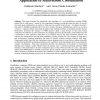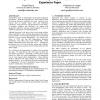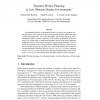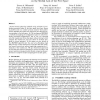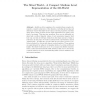101
click to vote
ICRA
2010
IEEE
14 years 11 months ago
2010
IEEE
— The problem of coverage of known space by a mobile robot has many applications. Of particular interest is providing a solution that guarantees the complete coverage of the free...
DCG
1998
15 years 11 days ago
1998
We present a simple and e cient paradigm for computing the exact solution of the motionplanning problem in environments with a low obstacle density. Such environments frequently o...
88
Voted
IJRR
2002
15 years 11 days ago
2002
: This paper describes the foundations and algorithms of a new probabilistic roadmap (PRM) planner that is: single-query
89
Voted
IJRR
2002
15 years 11 days ago
2002
Exact cellular decompositions represent a robot's free space by dividing it into regions with simple structure such that the sum of the regions fills the free space. These de...
102
Voted
SIAMCOMP
2000
15 years 13 days ago
2000
We study the problem of computing the free space F of a simple legged robot called the spider robot. The body of this robot is a single point and the legs are attached to the body....
100
click to vote
MVA
1990
15 years 1 months ago
1990
This paper proposes a novel representation of the free space of mobile robot by distinct, non-overlapping regions called Edge Visibility Regions (EVRs). An algorithm to partition ...
123
Voted
CIDR
2007
15 years 2 months ago
2007
Fragmentation leads to unpredictable and degraded application performance. While these problems have been studied in detail for desktop filesystem workloads, this study examines n...
WADS
1997
Springer
15 years 4 months ago
1997
Springer
A fundamental task for an autonomous robot is to plan its own motions. Exact approaches to the solution of this motion planning problem suffer from high worst-case running times. ...
104
click to vote
COMPGEOM
1999
ACM
15 years 5 months ago
1999
ACM
Several motion planning methods using networks of randomly generated nodes in the free space have been shown to perform well in a number of cases, however their performance degrad...
90
Voted
DAGM
2009
Springer
15 years 7 months ago
2009
Springer
Abstract. Ambitious driver assistance for complex urban scenarios demands a complete awareness of the situation, including all moving and stationary objects that limit the free spa...

